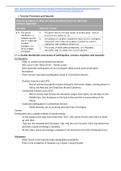https://qualifications.pearson.com/content/dam/pdf/A%20Level/Geography/2016/teaching-and-learning-materials/
Edexcel2016_ASandAlevelGeography_Topic1_TectonicProcessesandHazards_TopicBooklet.pdf
1. Tectonic Processes and Hazards
1. 1. a. Global distribution and causes of earthquakes, volcanic eruptions and tsunamis
Earthquakes:
- Often in clusters around plate boundaries
- 70% occur in the ‘Ring of Fire’ - Pacific coasts
- Most powerful earthquakes are at convergent (destructive) and conservative
boundaries
- There can be intra-plate earthquakes found in continental interiors
- Oceanic fracture zone (OFZ)
- Belt of activity through the oceans along the mid-ocean ridges, coming ashore in
Africa, the Red Sea, the Dead Sea rift and California.
- Continental fracture zone (CFZ)
- Belt of activity that follows the mountain ranges from Spain, via the Alps, to the
Middle East, the Himalayas to the East Indies and the circumscribing of the
Pacific.
- Scattered earthquakes in continental interiors
- Small minority can occur along old fault lines or hotspots.
Causes:
Earthquakes are a sudden release of stored energy.
- As two plates move past each other they ‘stick’, this causes friction and stress to build
up over time.
- They are not released until the plates ‘slip’ and the rock fractures (‘stick-slip behaviour)
and then a pulse of energy is released.
- All the strain, stress and energy is radiated in all directions from the earthquake focus.
Volcanoes:
- Often found in thin narrow strips along plate boundaries
- There is the exception of hotspots e.g. Hawaii, Canary Islands
, - There are about 500 active volcanoes, 50 of which erupt each year
Causes:
An opening in the Earth’s crust where magma, volcanic rock and gases from inside the earth
rise and are ejected into the surface.
Tsunamis:
- Distribution in terms of source area is fairly predictable
- 90% occur within the Pacific Basin, associated with activity at the plate margins
- Most are generated at subduction zones
Causes:
Generated when a submarine earthquake displaces the sea bed vertically as a result of
movement at a plate boundary.
- This motion displaces a large volume of water upwards.
- This water then moves outwards, in the form of waves, in all directions from the point
of displacement
- As the waves get close to shore, the wavelength decreases and their height increases
- Submarine earthquakes that occur close to the shores can cause violent shaking
damage, + the damage of the subsequent tsunami.
1. 1. b. Plate boundaries & distribution
● Divergent (constructive)
1. Mantle convection currents move plates apart
2. Tension forces cracks and faults to open between the two plates.
3. Magma will rise to fill in these gaps, creating new crust
4. Eruptions are small and effusive, as the erupted basaltic lava has low gas content and
high viscosity
○ Oceanic-oceanic
Convection currents bring magma to the surface, resulting in small, basaltic
eruptions creating new oceanic crust. Minor shallow earthquakes.
E.g. Mid-Atlantic ocean ridge at Iceland
○ Continental- continental
A magma plume splits the continental plate to create a new ocean basin.
Basaltic volcanoes and minor earthquakes.
,● Convergent (destructive or collison)
1. Mantle convection currents pull the plates towards each other, towards the subduction
zone.
2. The denser oceanic plate is subducted under the less dense continental plate.
3. The oceanic plate starts to melt due to the heat of the mantle. This creates excess
magma which will cause an eruption.
○ Oceanic-oceanic
One oceanic plate is subducted under another one, generating frequent and a
curving chain of volcanic islands that erupt.
E.g. Aleutian Islands, Alaska
○ Continental-continental
The collision between, creating a mountain belt as the landmasses crumple, and
magma is generated at a depth. There are infrequent major earthquakes
distributed over a large area. Eruptions are possible but rare as the magma
solidifies beneath the surface.
E.g. the Himalayas - Indo-Australian and Eurasian plates. There is no subduction
so fold mountains are created.
○ Oceanic-continental
An oceanic plate is subducted under a continental one, creating volcanoes.
Frequent large earthquakes and violent eruptions.
, E.g. Andean Mountains
● Conservative
1. Mantle convection currents slide the tectonic plates past each other, or along each
other in the same direction but at different speeds.
2. No plate subducts, they just rub against each other.
3. This creates friction that will be released as earthquakes.
○ Oceanic- continental
Plates slide past each other, along zones known as transform faults. Frequent
earthquakes, with a shallow focal depth, so they can be very destructive if they
are high magnitude. No volcanic activity.
E.g. San Andreas Fault - 1,200km in California
Distribution:




